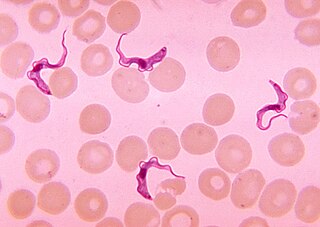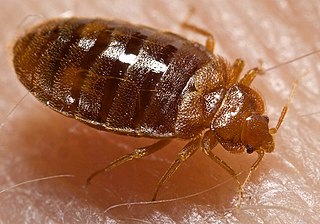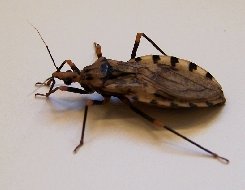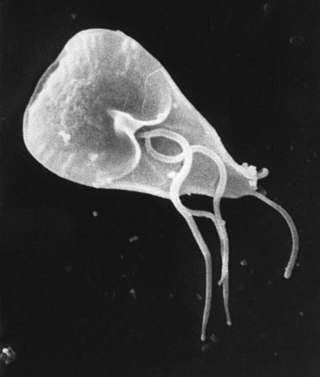
Chagas disease, also known as American trypanosomiasis, is a tropical parasitic disease caused by Trypanosoma cruzi. It is spread mostly by insects in the subfamily Triatominae, known as "kissing bugs". The symptoms change over the course of the infection. In the early stage, symptoms are typically either not present or mild, and may include fever, swollen lymph nodes, headaches, or swelling at the site of the bite. After four to eight weeks, untreated individuals enter the chronic phase of disease, which in most cases does not result in further symptoms. Up to 45% of people with chronic infections develop heart disease 10–30 years after the initial illness, which can lead to heart failure. Digestive complications, including an enlarged esophagus or an enlarged colon, may also occur in up to 21% of people, and up to 10% of people may experience nerve damage.

Triatoma protracta is a species of any mid sized insect in the family Reduviidae. It is known commonly as the western bloodsucking conenose. It is distributed in the western United States and Mexico.

Trypanosoma is a genus of kinetoplastids, a monophyletic group of unicellular parasitic flagellate protozoa. Trypanosoma is part of the phylum Euglenozoa. The name is derived from the Greek trypano- (borer) and soma (body) because of their corkscrew-like motion. Most trypanosomes are heteroxenous and most are transmitted via a vector. The majority of species are transmitted by blood-feeding invertebrates, but there are different mechanisms among the varying species. Trypanosoma equiperdum is spread between horses and other equine species by sexual contact. They are generally found in the intestine of their invertebrate host, but normally occupy the bloodstream or an intracellular environment in the vertebrate host.

Carlos Justiniano Ribeiro Chagas, or Carlos Chagas, was a Brazilian sanitary physician, scientist, and microbiologist who worked as a clinician and researcher. Most well known for the discovery of an eponymous protozoal infection called Chagas disease, also called American trypanosomiasis, he also discovered the causative fungi of the pneumocystis pneumonia. He described the two pathogens in 1909, while he was working at the Oswaldo Cruz Institute in Rio de Janeiro, and named the former Trypanosoma cruzi to honour his friend Oswaldo Cruz.

The Cimicidae are a family of small parasitic bugs that feed exclusively on the blood of warm-blooded animals. They are called cimicids or, loosely, bed bugs, though the latter term properly refers to the most well-known member of the family, Cimex lectularius, the common bed bug and its tropical relation Cimex hemipterus. The family contains over 100 species. Cimicids appeared in the fossil record in the Cretaceous period. When bats evolved in the Eocene, Cimicids switched hosts and now feed mainly on bats or birds. Members of the group have colonised humans on three occasions.

The members of the Triatominae, a subfamily of the Reduviidae, are also known as conenose bugs, kissing bugs, or vampire bugs. Other local names for them used in the Americas include barbeiros, vinchucas, pitos, chipos and chinches. Most of the 130 or more species of this subfamily feed on vertebrate blood; a very small portion of species feed on invertebrates. They are mainly found and widespread in the Americas, with a few species present in Asia and Africa. These bugs usually share shelter with nesting vertebrates, from which they suck blood. In areas where Chagas disease occurs, all triatomine species are potential vectors of the Chagas disease parasite Trypanosoma cruzi, but only those species that are well adapted to living with humans are considered important vectors. Also, proteins released from their bites have been known to induce anaphylaxis in sensitive and sensitized individuals.

Triatoma infestans, commonly called winchuka or vinchuca in Argentina, Bolivia, Uruguay and Chile, barbeiro in Brazil, chipo in Venezuela and also known as "kissing bug" or "barber bug" in English, is a blood-sucking bug and the most important vector of Trypanosoma cruzi which can lead to Chagas disease. It is widespread in the Southern Cone countries of South America. This region has joined the control intervention called Southern Cone Initiative managed by the PAHO.

Triatoma is a genus of assassin bug in the subfamily Triatominae. The members of Triatoma are blood-sucking insects that can transmit serious diseases, such as Chagas disease. Their saliva may also trigger allergic reactions in sensitive individuals, up to and including severe anaphylactic shock.

Panstrogylus geniculatus is a blood-sucking sylvatic insect noted as a putative vector of minor importance in the transmission of Trypanosoma cruzi to humans; this is a parasite, which causes Chagas disease. The insect is described as sylvatic; subsisting primarily in humid forests, and is also known to inhabit vertebrate nesting places such as those of the armadillo, and is also involved in enzootic transmission of T. cruzi to those species. It has wide distribution throughout 16 Latin American countries.

Rhodnius prolixus is the principal triatomine vector of the Chagas parasite due to both its sylvatic and domestic populations in northern South America as well as to its exclusively domestic populations in Central America. It has a wide range of ecotopes, mainly savanna and foothills with an altitude of between 500 and 1,500 metres above sea level and temperatures of 16 to 28 °C. Sylvatic R. prolixus, as virtually all Rhodnius spp., is primarily associated with palm tree habitats and has a wide range of hosts including birds, rodents, marsupials, sloths, and reptiles.

Triatoma dimidiata is a blood-sucking insect whose range extends from northern South America, throughout all the countries of Central America and into Southern Mexico. It is among the most important carriers of Trypanosoma cruzi, the flagellate protozoa that causes Chagas disease. Dimidiata has been found in rock piles, caves occupied by bats, hollow trees occupied by mammals or birds, and other diverse ecotopes. However, their presence in human abodes is usually happenstance; people tend to bring them indoors with their firewood. When in the nymph form they may camouflage themselves from predators by scraping dust over their dorsal abdomen, a behavior also observed in T. phyllosoma, T. nigromaculata, Panstrongylus geniculatus, P. megistus and P. herreri nymphs. Moreover, due to geological past in Mesoamerica such as forest loss, and rising temperatures, there has been an increase in Triatomine bugs infestation.

Trypanosoma cruzi is a species of parasitic euglenoids. Among the protozoa, the trypanosomes characteristically bore tissue in another organism and feed on blood (primarily) and also lymph. This behaviour causes disease or the likelihood of disease that varies with the organism: Chagas disease in humans, dourine and surra in horses, and a brucellosis-like disease in cattle. Parasites need a host body and the haematophagous insect triatomine is the major vector in accord with a mechanism of infection. The triatomine likes the nests of vertebrate animals for shelter, where it bites and sucks blood for food. Individual triatomines infected with protozoa from other contact with animals transmit trypanosomes when the triatomine deposits its faeces on the host's skin surface and then bites. Penetration of the infected faeces is further facilitated by the scratching of the bite area by the human or animal host.

Triatoma brasiliensis is now considered the most important Chagas disease vector in the semiarid areas of northeastern Brazil. T. brasiliensis occurs in 12 Brazilian states, including Maranhão, Piauí, Ceará, Rio Grande do Norte, and Paraíba.

In epidemiology, a disease vector is any living agent that carries and transmits an infectious pathogen such as a parasite or microbe, to another living organism. Agents regarded as vectors are mostly blood-sucking insects such as mosquitoes. The first major discovery of a disease vector came from Ronald Ross in 1897, who discovered the malaria pathogen when he dissected the stomach tissue of a mosquito.

Protozoan infections are parasitic diseases caused by organisms formerly classified in the kingdom Protozoa. These organisms are now classified in the supergroups Excavata, Amoebozoa, Harosa, and Archaeplastida. They are usually contracted by either an insect vector or by contact with an infected substance or surface.
Rhodnius nasutus is a Chagas disease vector native to the northeast of Brazil. It belongs to the family Reduviidae and subfamily Triatominae, which are commonly known as "kissing bugs" or "assassin bugs". They are considered a highly important species concerning the infectious Chagas disease as they carry the parasite Trypanosoma cruzi, that can be transmitted to the blood of mammals, including humans. This disease is an important issue in Brazil and central America due to the large number of Rhodnius species inhabiting these areas, however in recent efforts to reduce human infection, multiple variations of pesticides have dramatically reduced Triatomine populations. Therefore, the understanding and knowledge of Rhodnius nasutus greatly benefits our efforts in reducing life threatening infections.

Triatoma gerstaeckeri is an assassin bug in the genus Triatoma. It is an important vector of Trypanosoma cruzi, the causative agent of Chagas disease. The range of T. gerstaeckeri is from the south-western United States to north-eastern Mexico. T. gerstaeckeri goes through three stages during its paurometabolous life cycle: egg, nymphal instars and adult.
Triatoma indictiva is an arthropod in the assassin bug family of Reduviidae, and is an important vector of Trypanosoma cruzi. T. cruzi is the protozoan that causes Chagas Disease, which affects approximately eight million people a year in the western hemisphere alone. Triatoma indictiva is found in Mexico and throughout the southern United States, including Arizona and Texas.

Triatoma sordida is an assassin bug within the genus Triatoma. This species consists of three subspecies. Also referred to as kissing bugs, T.sordida are most well known for their role as a secondary vector of Chagas Disease. Inhabiting warm, dry climates, T.sordida are widely distributed throughout South America, occupying houses, farming structures, and wild habitats. Pest control is currently focused on insecticide application. However, biological controls utilizing fungi appear promising.

















